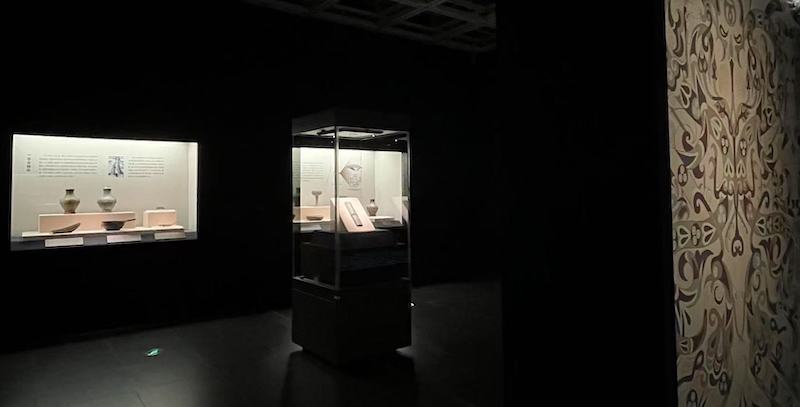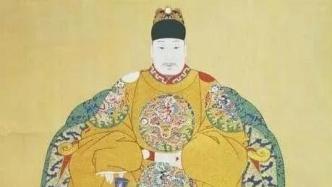
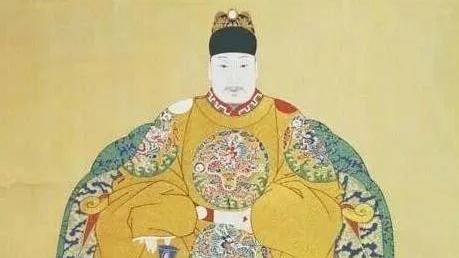
"At the beginning of the Ming Dynasty, it went out to sea and was illuminated by all the nations." During the Wanli period of the Ming Dynasty, politics gradually declined, while society, economy and culture showed the characteristics of the times of prosperity and cultural diversity.
On September 15, the exhibition "The Year of Wanli - Special Exhibition of Wanli Cultural Relics from the Ming Tombs" opened at the Shanghai Minhang Museum (Xinzhen Road). This exhibition reproduces the remarkable style and prosperity of the etiquette system, palace life, social economy, art and culture, and exchanges of ideas between China and foreign countries during the Wanli period of the Ming Dynasty. Through more than a hundred sets (pieces) of cultural relics, people can feel the Wanli period in the early globalization process. face.
The Paper has learned that this exhibition is jointly organized by the Minhang Museum and the Ming Dynasty Tombs Museum, and brings together the Jinji Shanguan, Jinjue, Dalu belt, blue and white plum vase, yellow silk tapestry with twelve chapters of good fortune and longevity, and silver gilt cloud and dragon pattern gargle. There are 116 sets (pieces) of precious cultural relics, including bowls and gold hairpins inlaid with cat's eye stone. The exhibition is divided into two parts: "Noble Artifacts of the Ming and Huang Dynasties" and "Glory to All Countries". It uses the crowns and robes of the Wanli Emperor and Empress, burial utensils, palace utensils, celadon calligraphy and paintings, gold and silver coins, etc. as physical carriers to reproduce the "rituals of the Wanli Dynasty". The ritual concepts of "sustainability" and "death as life" display exquisite and solemn palace skills and grand royal demeanor, present the various forms and outstanding achievements of social culture in the late Ming Dynasty, and the integration and collision of Chinese and foreign cultures under the background of the Age of Discovery. , trade relations.

Exhibition hall entrance
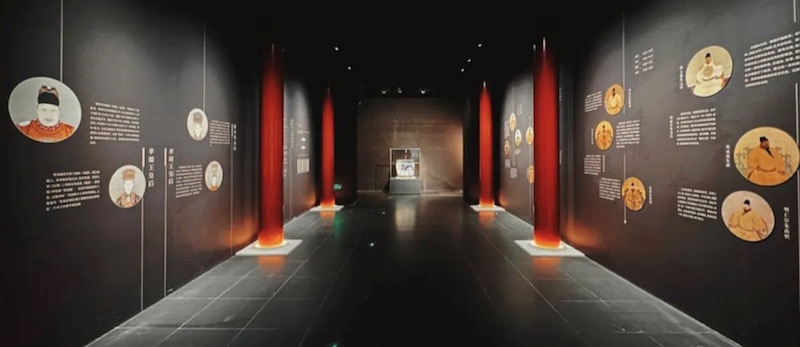
exhibition site
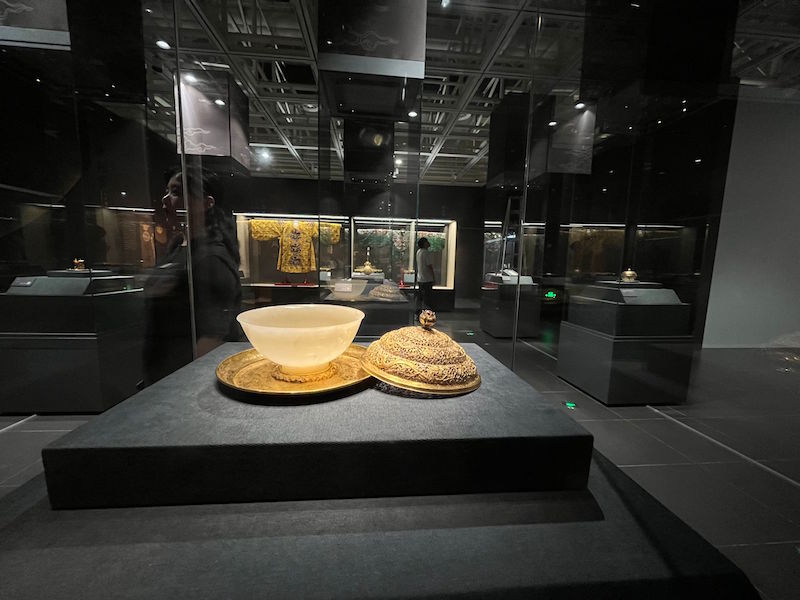
exhibition site
Emperor Wanli and Palace Life
During the Wanli period of the Ming Dynasty, it flourished in the early stage and then fell into silence, full of contradictions and controversies. During the decades of Emperor Wanli's rule, politics gradually declined, while society, economy and culture were completely opposite: the commodity economy flourished and humanities flourished, which greatly promoted the prosperity of culture and art in the late Ming Dynasty: the changing political environment and developed The commodity economy has given society a prosperous and culturally diverse character of the times. Reporters saw at the scene that this exhibition starts from the life story of Emperor Wanli and tells the historical stories, social life, culture and art of the Wanli period.
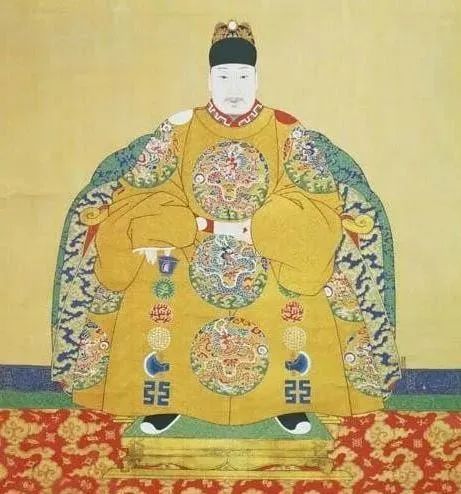
Pictures of Emperor Wanli Zhu Yijun come from the Internet
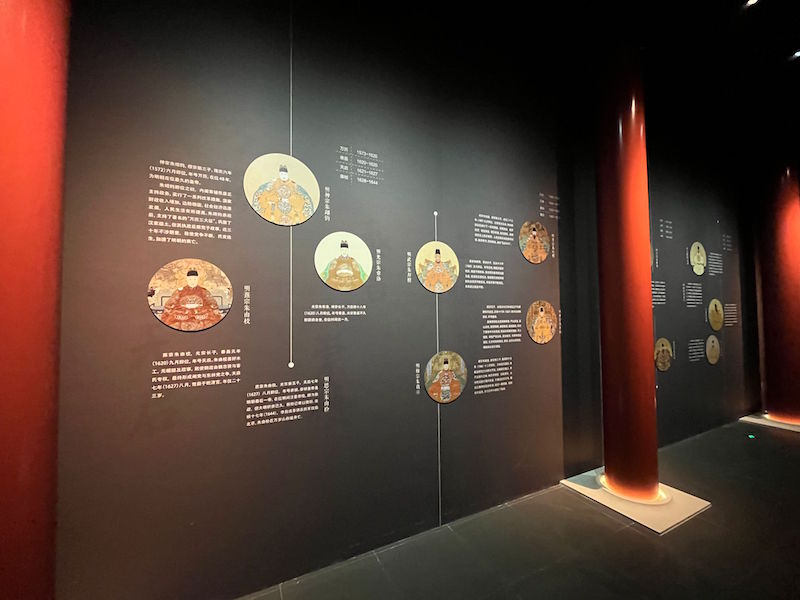
At the exhibition site, the exhibition walls sort out the emperors of the Ming Dynasty
Zhu Yijun (1572-1620), the Wanli Emperor in history, was the 13th emperor of the Ming Dynasty and the third son of Ming Mu Zong Zhu Zai. Zhu Yijun became emperor when he was 10 years old. He died of illness in 1620 and reigned for 48 years. His reign name was Wanli, his temple name was Shenzong, and his posthumous title was "Fan Tianhe, Daozhe, Sudun, Jianguang, Wu An, Renzhi Xiaoxian Emperor".
Some people divide Zhu Yijun's life into four stages: before the age of 10, and the period of crown prince. 10 to 20 years old, the period of the little emperor. After the age of 20, during his pro-government period, he was diligent in government affairs for a period of time, but was lazy in government affairs in the later period. When Zhu Yijun was established as the crown prince, Emperor Mu Zong appointed Zhang Juzheng as the crown prince's tutor. Thanks to the careful guidance of his cabinet ministers and the prince's master, as well as his mother's strict teachings, Zhu Yijun made rapid progress in his knowledge. When Zhang Juzheng died at the age of 20, Shenzong began to take charge of the government personally. For a period of time, he was diligent in government affairs and launched the "Three Major Expeditions of Wanli" to consolidate the territory of the Han family. Later, he was out of power for nearly 30 years due to conflicts with the civil servant group. During this period, the commodity economy in the Jiangnan area was highly developed, and the germination of capitalist production relations appeared. His life can be said to be extremely contradictory. As a generation of British masters, with the assistance of Zhang Juzheng, the Ming Dynasty's economy achieved unprecedented prosperity, and even the emergence of capitalism. However, he also indulged in extravagance, levied excessive taxes, and was burdened Eternal infamy.

Exterior view of Dingling Tomb of Ming Dynasty. Pictures from the Internet
Dingling, located at the eastern foot of Dayu Mountain in Beijing, is one of the Thirteen Tombs of the Ming Dynasty, where Zhu Yijun and his queen are buried. Dingling is the longest and most expensive imperial mausoleum in the entire Ming Dynasty. It is also the only Ming emperor's mausoleum that has been archaeologically excavated. According to records, the items buried in Dingling were extremely luxurious and rich.
In the exhibition hall, in addition to an introduction to Zhu Yijun's life, the audience can also see precious cultural relics from Dingling, including the Golden Wing Shanguan, Jinjue, Dali Dai, Twelve Dragons and Nine Phoenixes Guan, and Huang Kesi Twelve Chapters of Good Luck and Longevity. , hollow gold cover, gold tray, jade bowl, etc. Minhang Museum staff told reporters that unfortunately, because the four cultural relics including the Golden Wing Crown and the Gun Clothes are not allowed to leave Beijing, they can only be replaced with replicas for this exhibition.

Golden Winged Crown (This exhibition is a copy)
The Golden Wing Shan Crown was created by Emperor Taizong of the Tang Dynasty according to the ancient system during the Zhenguan period. It was a hat worn by the emperor when he wore ordinary clothes. Because the corner of the hat is folded upward to resemble the word "shan", it was named Yi Shan.
This golden-winged crown worn by Zhu Yijun, Emperor Shenzong of the Ming Dynasty, is made of 852 0.2 mm gold wires woven by hand. The gold wires are of the same density, with even gaps, and are as thin as light gauze. The production adopts various processes such as filigree, tired wire, coded wire, and welding. Its complex structure, fine workmanship, well-proportioned holes, no trace of joints on the surface, and vivid and powerful dragon shape fully reflect the highest skills of gold and silver finery in the Ming Dynasty. It is also the only imperial gold crown existing in my country so far. So precious.
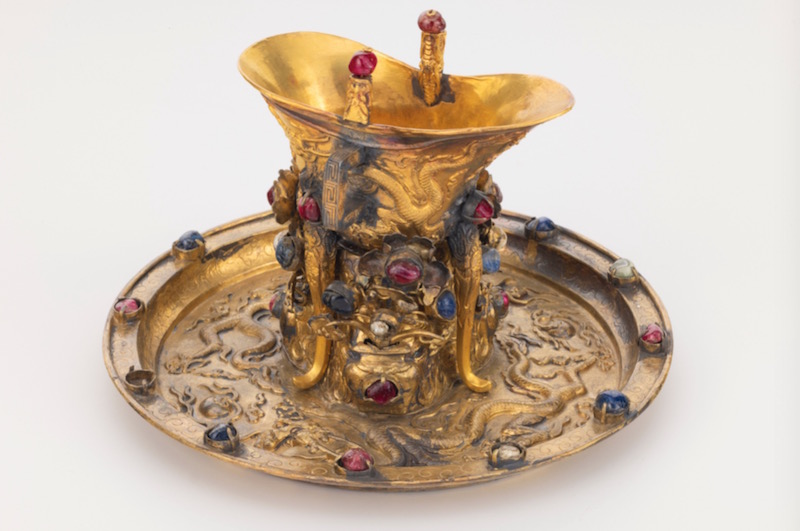
Jin Jue
The golden jue was an artifact used by emperors and important ministers and was a symbol of status. A total of four golden jue pieces were unearthed from Dingling, and this piece is one of them. Its three legs, columns, handle and body are made separately and then welded together. There is a tree-stump-shaped column in the center, and three sides are carved into the shape of a vase, with a flower embedded with jewels inserted in each vase. The outer wall of Jue's belly is engraved with semi-relief patterns of two dragons playing with beads and sea water, rivers and cliffs with cloud patterns. These are patterns commonly used in ancient royal and aristocratic supplies. The upper parts of the three legs and the tops of the two pillars are each inlaid with a ruby. The inserted peony branches are not only inlaid with red and sapphires, but also decorated with gold and silver ingots, corals, rhinoceros horns and other eight treasures. The craftsmanship is extremely exquisite. It can be seen that the production technology of goldware in the Ming Dynasty was more mature and more exquisite.

dalu belt
The Dalu belt is the belt of Ming Shenzong Zhu Yijun. The belt was an important accessory of uniforms in the Ming Dynasty. From the emperor down, princes, nobles, civil and military officials wore different belts according to their positions. This belt is made of precious materials and richly decorated. It is speculated that it was a belt worn by Emperor Wanli on important occasions and evolved from the jade belt of the Ming Dynasty. The shape and number of gems inlaid on the Dalu belt also refer to the relevant clothing system of the Ming Dynasty and are made according to certain requirements. According to statistics from the excavation report, there were 20 emeralds and 91 pomegranate seed rubies. So far, only one jade belt of this style has been found.
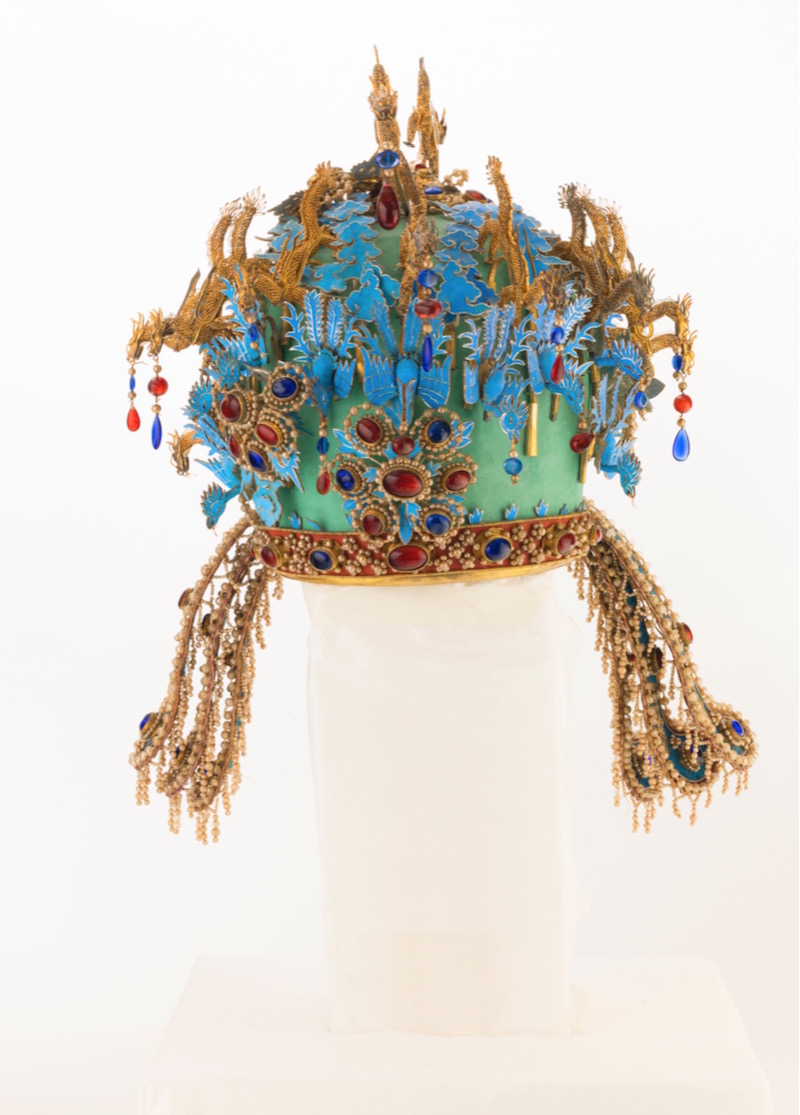
Twelve dragons and nine phoenix crowns (this exhibition is a replica)
The crown with twelve dragons and nine phoenixes was worn by Empress Xiaojing. Empress Xiaojing was the imperial concubine of Emperor Wanli during her lifetime. Ten years after her death, her grandson Mingxi Zong moved her to Dingling and buried her with corresponding funeral arrangements. The dragon and phoenix crown is the crown that goes with the queen's dress, and is worn when receiving orders, visiting temples, and court gatherings. The upper part is flat and wide, with a lacquered bamboo body and a golden ring. There are openings on both sides of the ring mouth, suitable for inserting hairpins. The crown is decorated with twelve dragons and nine phoenixes. The dragons are made of filigree. They may be soaring, standing upright on all fours, walking, or galloping in different postures. The phoenixes are dotted with green emeralds, as if they are flying with their heads held high.

White jade "Shou" character inlaid with precious stones and gold hairpin
The white jade "Shou" character inlaid with gemstones and gold hairpin is the jewelry of Empress Xiaoduan. The top is made of peach-shaped and cloud-shaped filigree gold supports and "Shou"-shaped supports. The supports are decorated with peach-shaped and cloud-shaped white jade, red jade and green jade, and the center is a white jade ornament in the shape of "Shou".

Hollow gold cover, gold tray and jade bowl
The hollow gold lid, gold tray and jade bowl are made of gold and jade. The jade bowl is made of white jade, which is delicate, smooth and flawless. The jade bowl is covered with a gold lid, with a hollow cloud pattern as the ground, a pattern of dragons chasing beads, a lotus-shaped button on the top, and a ruby embedded in the center. The dragon's posture is strong and graceful, as if leaping into the air. There is a gold tray under the bowl, and a foot-shaped bowl holder is pressed inward from the outer wall in the center of the bottom to fit the bottom of the bowl. Eight groups of neat cloud patterns are carved on the inner wall of the pan. The bottom is sand, with two dragons chasing beads and cloud patterns carved on it. In the middle, the bowl holder is engraved with cloud patterns, and the outside of the holder is decorated with a continuous moire pattern in relief.
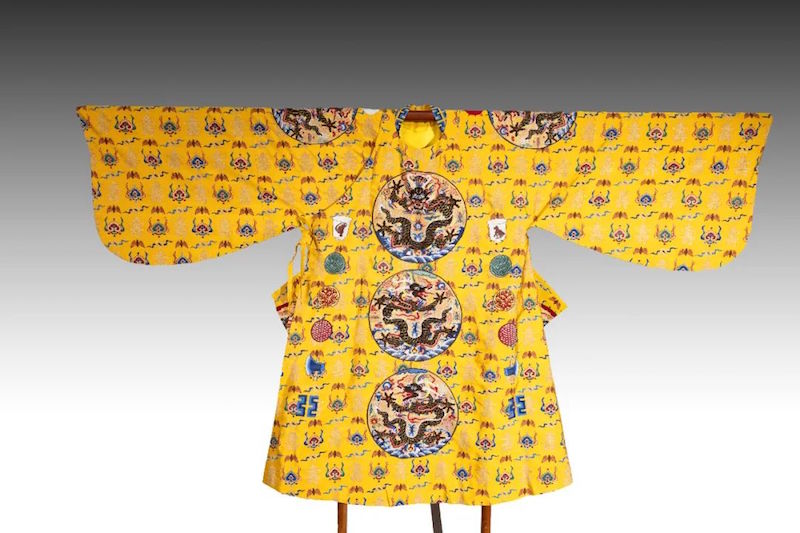
Huang Kesi Twelve Chapters of Good Luck, Longevity and Good Luck (This exhibition is a copy)
Gongfu is the highest-level dress worn by emperors of the Ming Dynasty. It is used for worshiping heaven and earth, ancestral temples, ascending the throne, worshiping and other major ceremonial occasions. According to the "Da Ming Hui Dian", the Gongfu consists of two parts: the upper garment and the lower garment. It is decorated with twelve chapter patterns such as the sun, moon, and stars, and is worn with a crown. In addition to the gown-shaped gown, there was also a robe-style gown in the Ming Dynasty, which was also decorated with twelve chapters, and the crown was a wing-shaped crown instead of a crown.
This Yellow Kesi Twelve Chapters of Good Luck and Longevity is a robe-style gown and was the costume of Emperor Wanli. The entire garment is divided into a large front piece, a small front piece and a back piece. The three large pieces are not connected to each other. The lining of the robe is made of yellow gauze, and there is a layer of interlining between the top and the lining of the robe, which is composed of three different fabrics, namely silk, gauze and Luo, sewn together. There is a ribbon nose nailed to the left armpit, two ribbons are nailed to each of the big and small lapels under the right armpit, and the cuffs are lined with satin. On the bottom are the two characters "卍生", Ruyiyun, and bats. There are three dragons on the front and back of the robe, two dragons on the left and right sides, and one dragon on each shoulder. The left and right shoulders are decorated with sun, moon and Chinese insects, the upper part of the back is decorated with stars and mountains, and the lower part of the dragon is decorated with Zongyi, Zao, Huo, Fenmi, 黼, and 黻 on both sides. The lower part of the dragon is decorated with the longevity mountain and the sea of blessings, surrounded by eight auspicious patterns, fire beads and flowing clouds. The body of the dragon is covered with peacock feathers, the dragon is surrounded by gold, and the character "Shou" is made of round gold. According to records, it took kesi craftsmen 13 years to make this Gong suit, using more than a dozen precious materials including 50,000 meters of gold thread and 6,000 peacock downs. There are 12 auspicious patterns on the top and bottom of Gun's suit, including 12 dragons, sun, moon and stars. There are 279 ten thousand characters, 256 longevity characters, 301 bats and 271 wishful thinking all over the body.
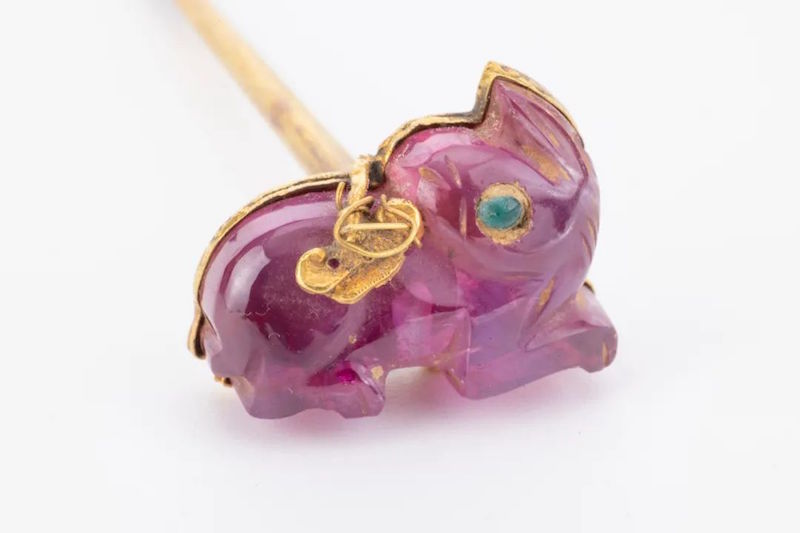
Wanli Emperor jewelry with amethyst inlaid rabbit gold hairpin. The gold base on the top is inlaid with an amethyst rabbit, and there is a gold Ganoderma lucidum on the back. The rabbit is crouching, looking back, with erect ears and eyes inlaid with emeralds.
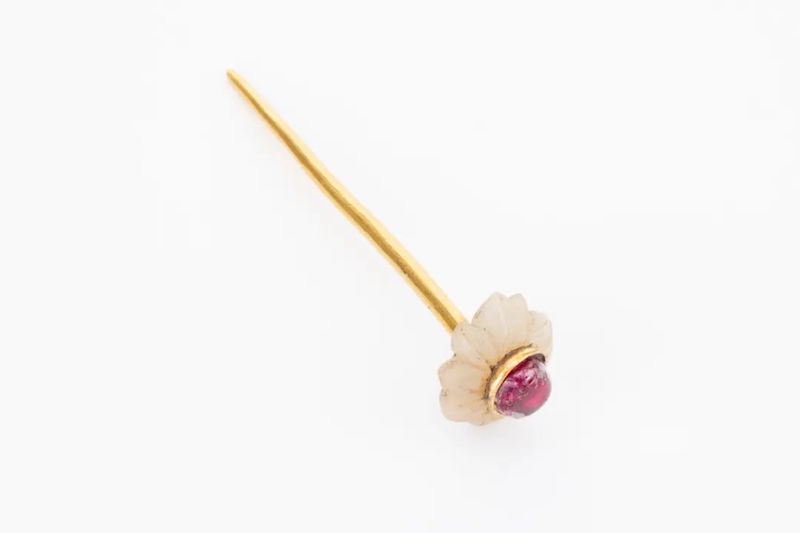
White jade inlaid ruby gold hairpin Wanli Emperor jewelry. The top is covered with a lotus-shaped white jade flower and a gold holder, with a pomegranate seed and ruby inlaid on it.
Commerce and Culture during the Wanli Period
Beginning in the middle Wanli period, China's porcelain trade with Southeast Asian and Western countries entered a new stage. With the opening of overseas markets, Chinese porcelain was continuously shipped to various parts of the world by Portuguese and Dutch merchant ships, and was sought after and collected by European society. Porcelain became one of the most popular handicrafts in Europe, Japan, Southeast Asia and other regions at that time.
The exhibition also presents to the audience a number of porcelains from the Wanli period of the Ming Dynasty, including cultural relics related to the Ming Dynasty sunken ship "Nana'ao No. 1". The "Nanao No. 1" was discovered in 2007. It was a foreign trade merchant ship from Longqing to the middle of Wanli. The porcelain it produced is not only a representative of the technology, culture and art of the Ming Dynasty, but also an important physical evidence of the cultural and trade exchanges of the Maritime Silk Road.

exhibition site
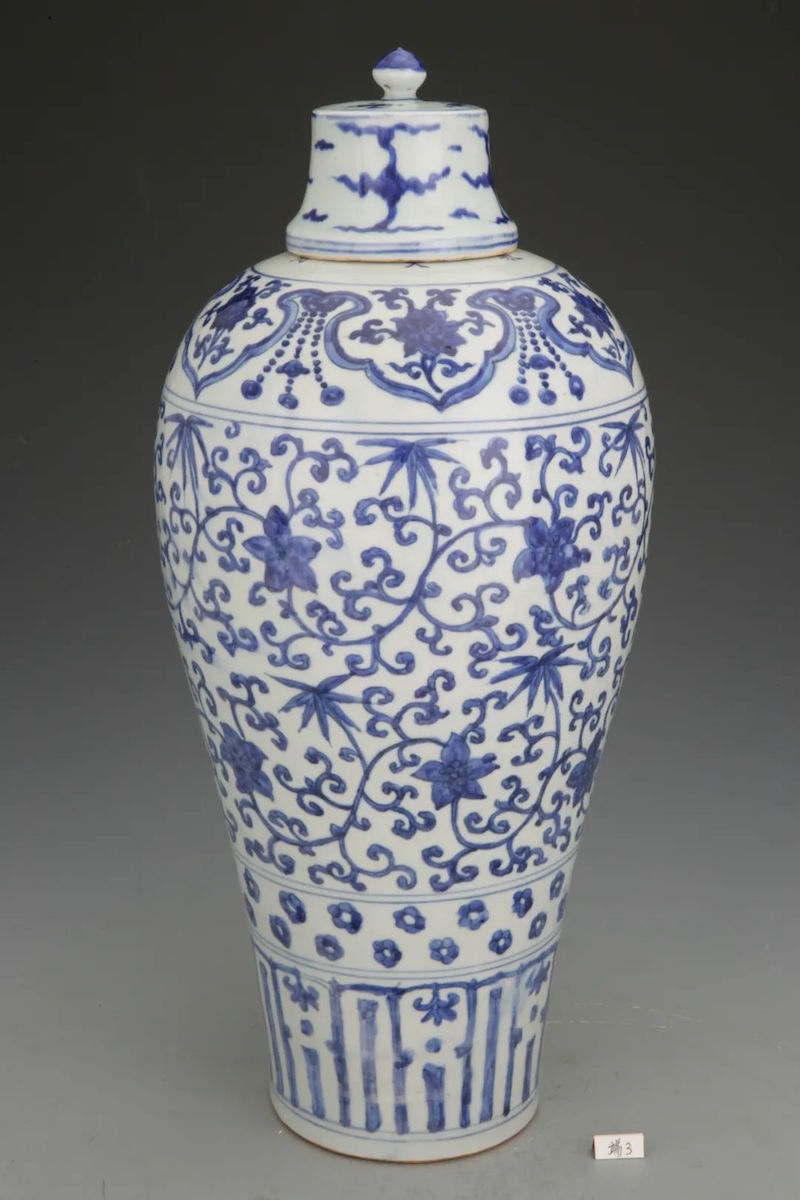
Blue and white plum vase
The plum vase is a vase with a small mouth, short neck, plump shoulders, tight belly, and round feet. It is named because its mouth is so small that it can only hold plum branches. Eight blue and white plum vases were unearthed from the Dingling Mausoleum and were placed around the coffins of the emperor and empress to symbolize "peace in all directions and stability in all directions".

Blue and white plum blossom style basin
This blue and white multicolored basin was produced in Jingdezhen Kiln. The overall porcelain basin is in the shape of a five-petal plum blossom, with regular shape, delicate texture and shiny glaze. The interior edge of the mouth is decorated with brocade and algae and swimming shrimps, and the exterior is decorated with falling flowers and flowing water patterns. Both the inner and outer walls adopt a panoramic composition, decorated with shrimps swimming in the water and reed geese on the riverside respectively. The inner bottom is decorated with sea water and river cliffs, two running deers, blooming plum blossoms, two flying bats and the Qian Gua symbol, symbolizing fortune and fortune. The pattern layout is dense and the colors are rich and gorgeous. The center of the outsole is concave, with a blue and white "Da Ming Wanli Year System" six-character double-line double-circle regular script vertical inscription.

Blue and white figure plate
The whole body is of fine texture and decorated with blue and white patterns. The outer wall is decorated with branches, flowers and fruits, and the inner wall is decorated with a circle of dragons playing with beads and clouds and phoenixes. The porcelain plate is painted with a historical story of "Xiao He chasing Han Xin under the moon". You can see Han Xin standing on the riverside waiting to be crossed, surrounded by willow trees, ships and lingering clouds, Xiao He galloping from afar on horseback and whipping his whip. The overall composition is clever and the painting is fine. In the center of the outsole is a blue and white "Da Ming Wanli Year System" double circle and double line regular script vertical inscription.

The gold ingot is sub-waist-shaped, slightly concave in the middle of the front and slightly bulging on the back. The front is engraved with "90% gold and 10 taels", and the back is engraved with "In the 46th year of Wanli, the Household Department entered the shop in Daxing County and Yan Hong and others bought it."
In addition to the prosperity of the commodity economy, the cultural development of literature, opera, astronomy and calendar in the late Ming Dynasty also made outstanding achievements, exuding great cultural interest and spiritual charm. Emperor Wanli encouraged the compilation of official books and commercial publishing, and daily-use books were widely circulated. His books compiled all kinds of common knowledge needed for daily life, such as farming, medicine, diet, living room, calendar, weather, etc. into one volume, or Excerpts from classics may be taken from folk customs, or may include slang, or may include pictures and texts for the use of scholars, farmers, industry, and merchants.
For this reason, the Ming Dynasty was the second golden age in the history of Chinese opera after the Yuan Dynasty drama, and drama became an indispensable cultural activity for urban residents. In the middle and late Ming Dynasty, with the prosperity of the urban economy, operas that were popular with the masses saw new developments, such as Tang Xianzu's representative work "The Peony Pavilion". At the same time, novel creation flourished in the Ming Dynasty, producing a large number of long chapter novels with themes of history, gods and monsters, and daily life of citizens.

Dong Qichang's "Lin Wang Xizhi's Cursive Scroll", collected by the Archives of Minhang District, Shanghai
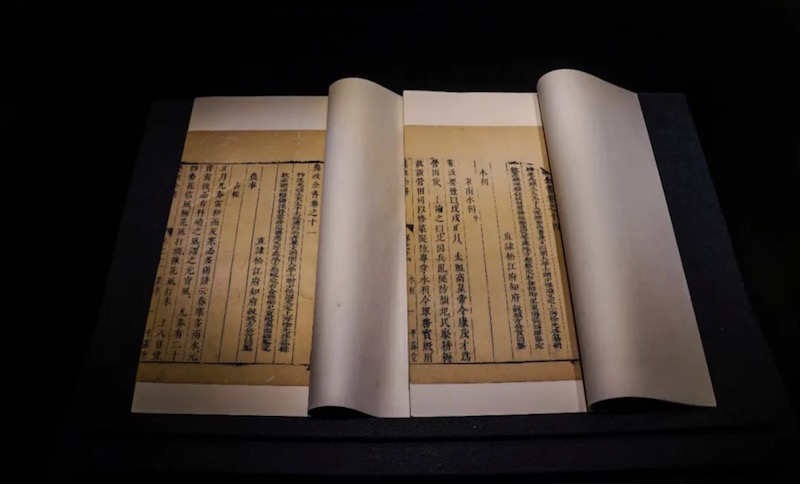
The engraving of "The Complete Book of Agricultural Affairs" in Pinglu Hall, Songjiang Prefecture, Chongzhen City, Ming Dynasty, collected by Tushanwan Museum (Xu Guangqi Memorial Hall)
In this section, the key exhibits that the audience can see include Dong Qichang's "Lin Wang Xizhi's Cursive Hand Scroll" and the "Agricultural Administration Complete Book" engraved in Pinglutang, Songjiang Prefecture, Chongzhen of the Ming Dynasty. Due to the limited exhibition space, the display in this section mainly focuses on the introduction of exhibition boards.
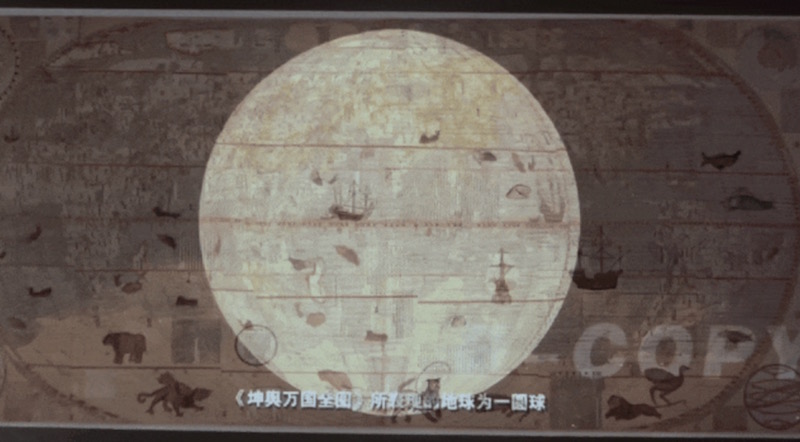
Exhibition hall scene
It is worth mentioning that this exhibition continues the Minhang Museum's consistent image presentation method, such as the panoramic dynamic projection of "Kunyu and the Complete Map of All Nations" in the exhibition prologue hall, using the world map drawn by Matteo Ricci as the narrative background to construct a The vivid animated images compare and connect the world of the same period with the Wanli of Ming Dynasty across time and space; in the "Things Have a Universe" exhibition area, around the display of cultural relics in the blue and white plum blossom pots, the video is designed to play, and through the interest in the decorative details of the cultural relics The combination and dynamic performances allow the audience to appreciate the elegant, delicate, smart and refined artistic style and aesthetic characteristics of Ming Dynasty blue and white porcelain; in the "Literary and Broadcasting World" exhibition area, the materials are drawn from the "Police Map" and "Police Map" drawn by Emperor Wanli on his expeditions and travels. "Enter the Cross" creates an immersive art picture of the Ming Dynasty, recreating the majestic and majestic scenes of the Wanli princes and nobles traveling in the Ming Dynasty.
The exhibition will last until November 26th.

